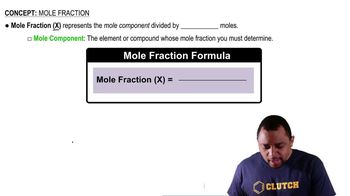Here are the essential concepts you must grasp in order to answer the question correctly.
Density and Molar Mass
Density is defined as mass per unit volume and is a crucial property for gases. At standard temperature and pressure (STP), the molar mass of a gas can be related to its density using the ideal gas law. For a mixture, the average molar mass can be calculated from the densities and mole fractions of the individual gases.
Recommended video:
Mole Fraction
Mole fraction is a way of expressing the concentration of a component in a mixture. It is defined as the ratio of the number of moles of a specific component to the total number of moles of all components in the mixture. This concept is essential for determining the composition of gas mixtures and can be calculated once the moles of each gas are known.
Recommended video:
Ideal Gas Law
The ideal gas law relates the pressure, volume, temperature, and number of moles of a gas through the equation PV = nRT. This law is fundamental in calculating the behavior of gases under various conditions. For mixtures, the law can be applied to find the total pressure and relate it to the partial pressures of the individual gases, which are directly linked to their mole fractions.
Recommended video:
 Verified step by step guidance
Verified step by step guidance

